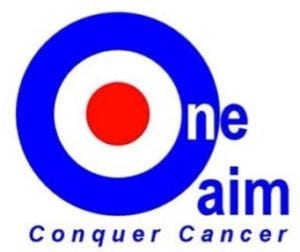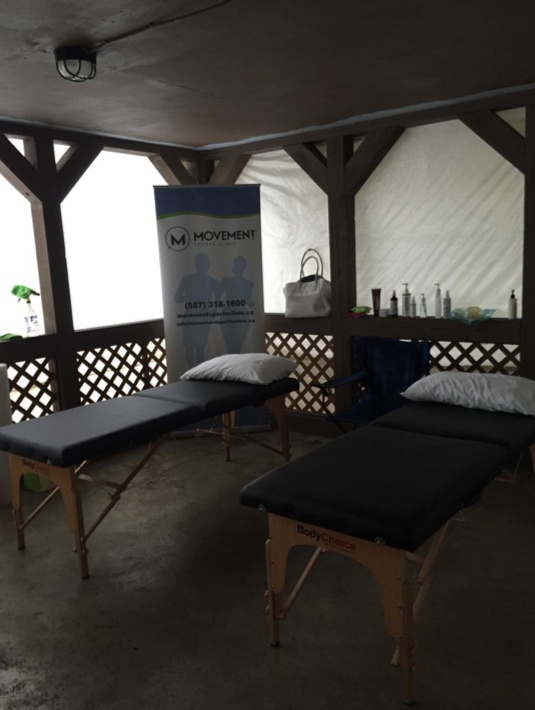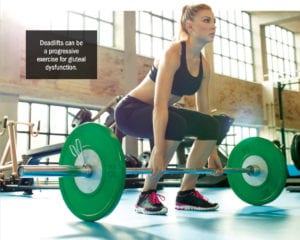Life is pretty easy on us physically. We have escalators, elevators, cars and comfy chairs. In the hunter-gatherer days of our ancestors, the average male walked 10K a day and females averaged
6K. Squatting was an everyday activity for doing tasks, eating meals and even going to the toilet that most cultures have all but eliminated from daily life. And it’s the deep squat that uses the gluteals more effectively than any other movement.
Injured runners often test positively for gluteal inhibition or delayed recruitment patterns. Because the body is hardwired to keep us going, the nervous system simply recruits other muscles when the gluteals are not available. is over-activity of some muscles and under-activity of others can contribute to problems such as back pain, iliotibial band (IT) band dysfunction and plantar fasciitis. It is a paradox that pushing muscles to their limits may very well be the key contributor to muscular inhibition patterns that shut them down.
When the gluteals are weak, the hamstrings tend to get tight in compensation.
Commonly with back pain, the gluteals are weakened from reflex spinal inhibition. When the gluteals are weak, the hamstrings tend to get tight in compensation. Stretching often won’t lengthen or relax the hamstrings until the gluteals start doing their job. e hip flexors can also get tight, compensating for weak or inhibited gluteals. It may be a chicken-or-egg scenario. If you sit too much, the gluteals get weak and the hip flexors get shortened or tight. Tight hip flexors mean the hip can’t extend well, which makes it more di cult to get your gluteals ring. Mix in lumbar flexion from sitting in a slump and there is neurological inhibition to add to the dysfunction.
Manual muscle testing can assess how well your gluteals are working. Looking at muscular dominance patterns of movements like the hip bridge and single leg squat can give good information on how the body is recruiting muscles and expose compensation patterns.
Getting muscles to turn on again can be as simple as starting to use them again, but in many cases the nervous system requires a stimulus to overcome an ingrained faulty movement pattern. Muscle release techniques, activation and mobility exercises and dry needling or intramuscular stimulation (IMS) can all be used in concert to get the body moving optimally again.
Once a muscle starts to function again, repetition is needed to retrain the brain and nervous system’s motor pathways. Exercises such as bridges, squats and clamshells need to be done frequently under low to moderate loads to help retrain the movements.
Depending on sport and lifestyle goals, once muscles are being properly recruited they may need to be challenged through progressive functional movements with variable loads and speeds.Weighted squats, deadlifts, box jumps and kettlebell swings can all be progressive exercises for gluteal dysfunction, once muscles are actually recruiting normally and not using compensatory muscle patterns
Weighted squats, deadlifts, box jumps and kettlebell swings can all be progressive exercises for gluteal dysfunction, once muscles are actually recruiting normally and not using compensatory muscle patterns
 The route was 8km loops through the Parkland neighborhood in southeast Calgary. Movement Sports Clinic offered aid to the riders to help keep them rolling. Organizers had created a cozy and warm treatment space behind the food area for the physiotherapists to work on injured or fatigued participants.
The route was 8km loops through the Parkland neighborhood in southeast Calgary. Movement Sports Clinic offered aid to the riders to help keep them rolling. Organizers had created a cozy and warm treatment space behind the food area for the physiotherapists to work on injured or fatigued participants.





 We all have muscles that tend to be weak or inhibited and those that tend to be tight and overactive. Postural habits and the impact of gravity can be primary reasons for these patterns to occur, but injury, inactivity and pain can also lead to this reflexive turning off or hyper stimulation of muscles by the nervous system. In some cases our muscles, particularly big muscles like the gluteus maximus, forget how to work.
We all have muscles that tend to be weak or inhibited and those that tend to be tight and overactive. Postural habits and the impact of gravity can be primary reasons for these patterns to occur, but injury, inactivity and pain can also lead to this reflexive turning off or hyper stimulation of muscles by the nervous system. In some cases our muscles, particularly big muscles like the gluteus maximus, forget how to work.


